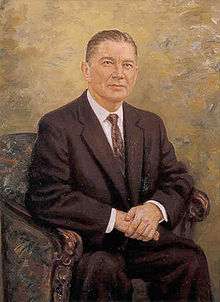Wilbur Mills
Wilbur Daigh Mills (May 24, 1909 – May 2, 1992) was an American Democratic politician who represented Arkansas's 2nd congressional district in the United States House of Representatives from 1939 until his retirement in 1977. As chairman of the House Ways and Means Committee from 1958 to 1974, he was often called "the most powerful man in Washington."
Wilbur Mills | |
|---|---|
 | |
| Chair of the House Ways and Means Committee | |
| In office January 7, 1958 – December 10, 1974 | |
| Preceded by | Jere Cooper |
| Succeeded by | Al Ullman |
| Member of the U.S. House of Representatives from Arkansas's 2nd district | |
| In office January 3, 1939 – January 3, 1977 | |
| Preceded by | John E. Miller |
| Succeeded by | Jim Guy Tucker |
| Personal details | |
| Born | Wilbur Daigh Mills May 24, 1909 Kensett, Arkansas, U.S. |
| Died | May 2, 1992 (aged 82) Searcy, Arkansas, U.S. |
| Political party | Democratic |
| Spouse(s) | Clarine Billingsley ( m. 1934) |
| Alma mater | Hendrix College Harvard University |
Born in Kensett, Arkansas, Mills pursued a legal career and helped run his father's bank after graduating from Harvard Law School. He served as the county judge of White County, Arkansas before winning election to the United States House of Representatives in 1938. As Chairman of the Ways and Means Committee, Mills played a large role in the establishment of Medicare. He also helped pass the Tax Reform Act of 1969, which created the alternative minimum tax.
Mills ran for president in 1972, championing an automatic Cost of Living adjustment to Social Security, but he performed poorly in the Democratic primaries. After two public incidents with a stripper named Fanne Foxe, he declined to seek re-election in 1976. After leaving office, he returned to the practice of law and helped establish a center for the treatment of alcoholism.
Youth and early political life
Mills was born in Kensett in White County to Abbie Lois Daigh Mills and Ardra Pickens Mills.[1] Kensett was the first public school in Arkansas to integrate, under Mills' father, who was first superintendent and then chairman of the school board and the banker for the school district. Mills attended public schools in Kensett but graduated as valedictorian from Searcy High School in the county seat of White County. He thereafter graduated from Hendrix College in Conway as salutatorian, having resided in Martin Hall. He studied constitutional law at Harvard Law School in Cambridge, Massachusetts under Felix Frankfurter, who was subsequently nominated and confirmed (1939) as an Associate Justice of the United States Supreme Court. Mills returned to Arkansas to run his father's bank in 1933 in the Great Depression and was admitted to the Arkansas Bar Association bar in 1933.
Mills served as the 29th county judge of White County, between 1935 and 1939, and began a county-funded program, with a $5,000 fund to pay medical bills (equivalent to $92,000 in 2019),[2] prescription drugs which were sold at cost, and hospital treatment for the indigent which were lowered to $2.50 per day (equivalent to $46 in 2019),[2] as well as have doctors see qualified patients free of charge. Patients were qualified for the program through petitioning the local justice of the peace, who would in turn make a recommendation to Mills as county judge.
In Congress
House Ways and Means Committee
Mills served in Congress from 1939 to 1977, 17 of them (1958–1974)[3] as chairman of the powerful House Ways and Means Committee, a post he held longer than any other person in U.S. history. Mills was often termed "the most powerful man in Washington" during his tenure. He was a signatory to the 1956 Southern Manifesto that opposed the desegregation of public schools ordered by the Supreme Court in Brown v. Board of Education.
His accomplishments in Congress included playing a large role in the creation of the Medicare program.[4] Mills initially had reservations about the program because he was worried about the eventual cost, especially since the early proposals by the President and some Members of Congress proposed funding for Medicare from the Social Security Trust Fund, but Mills eventually shepherded it through Congress and had a large hand in shaping its program. His original concern was that because medical costs continued to rise each year, both Social Security and Medicare would have to be terminated due to these escalating costs. Mills was also acknowledged as the primary tax expert in the Congress and the leading architect of the Tax Reform Act of 1969. Mills favored a conservative fiscal approach, adequate tax revenue to fund government programs, a balanced budget, while also supporting various social programs, especially Social Security and Disability, adding farmers to Social Security, unemployment compensation, and national health insurance.
In 1967, when President Lyndon Johnson required funds to support the cost of escalating the Vietnam War, Mills refused to close tax loopholes on higher-income earners, and demanded that tax increases be matched by equivalent cuts to Great Society programs.[5]
Presidential candidate
Mills was drafted by friends and fellow Congressmen to make himself available as a candidate for President of the United States in 1972 in a few of the Democratic primaries. To position himself to appeal to senior citizens during the 1972 presidential campaign, Mills championed the automatic Cost Of Living Adjustment (COLA) to Social Security. He was not strong in the primaries and won 33 votes for president from the delegates at the 1972 Democratic National Convention which nominated Senator George McGovern. His name was mentioned as a possible Secretary of Treasury in a McGovern administration, but McGovern's resounding defeat by President Richard Nixon made this moot.[6]
Sex scandal, alcoholism, and retirement
Mills was involved in a traffic incident in Washington, DC at 2 a.m. on October 9, 1974.[7] U.S. Park Police stopped his car late at night because he had not activated the vehicle's headlights. Mills was intoxicated, and his face was injured following a scuffle with Annabelle Battistella, better known as Fanne Foxe, a stripper from Argentina. When police approached the car, Foxe leapt from the vehicle and jumped into the nearby Tidal Basin in an attempt to escape.[7][8][9] She was taken to St. Elizabeths Mental Hospital for treatment.
Despite the scandal, Mills was re-elected to Congress in November 1974 in a heavily Democratic year with nearly 60% of the vote, defeating Republican Judy Petty. On November 30, 1974, Mills, seemingly drunk, was accompanied by Fanne Foxe's husband onstage at The Pilgrim Theatre in Boston, a burlesque house where Foxe was performing. He held a press conference from Foxe's dressing room.[7] Soon after this second public incident, Mills stepped down from his chairmanship of the Ways and Means Committee, acknowledged his alcoholism, joined Alcoholics Anonymous, and checked himself into the Palm Beach Institute in West Palm Beach, Florida.[10]
Mills did not run for re-election in 1976 and was succeeded by Democrat Jim Guy Tucker.[11][12] Thereafter, Mills practiced law at the prestigious Shea and Gould Law Firm of New York's Washington Office, until he retired in 1991 and moved back to Arkansas to work on the establishment of the Wilbur D. Mills Treatment Center for Alcoholism, the University of Arkansas for Medical Sciences's Wilbur D. Mills Endowed Chairs on Alcoholism and Drug Abuse, and the Masonic Grand Lodge's fundraising campaign.
Mills died in Searcy, Arkansas in 1992. He is interred at Kensett Cemetery in Kensett, Arkansas.[13]
Personal life
He was married to Clarine Billingsley "Polly" Mills until his death in 1992; she died in 2001. They are interred side by side at the Kensett Cemetery.[14]
Honors
Various schools, highways, and other structures in Arkansas are named for Mills:
- Wilbur D. Mills University Studies High School in Sweet Home, Pulaski County, Arkansas
- Wilbur D. Mills Treatment Center for Alcoholism and Drug Abuse, Searcy, Arkansas
- Wilbur D. Mills Dam on the Arkansas River in Arkansas County and Desha County, Arkansas
- Wilbur D. Mills Campgrounds, Tichnor, Arkansas
- Wilbur D. Mills Freeway in Little Rock, Arkansas (Interstate 630)
- Wilbur D. Mills Avenue in Kensett, Arkansas
- Wilbur D. Mills Park in Bryant, Arkansas
- Wilbur D. Mills Building, Hendrix College, Conway, Arkansas
- Two Wilbur D. Mills Endowed Chairs on Alcoholism and Drug Abuse, University of *Arkansas Medical Science Campus
- Wilbur D. Mills Education Services Cooperative, Beebe, Arkansas
- Mills Park Road, Bryant, Arkansas
- Mills Street, Walnut Ridge, Arkansas
- Wilbur D. Mills Courts Building, Searcy, Arkansas
- Wilbur D. Mills Library, Arkansas School for the Deaf, Little Rock, Arkansas
Sculptures of Mills are located at:
- Arkansas State Capitol
- Hendrix College, Mills Building, Mills Congressional Office Replica
- Wilbur D. Mills University Studies High School, Sweet Home, Arkansas
- Wilbur Mills Treatment Center, Searcy, Arkansas
- Boswell Law Office, Bryant, Arkansas
- Kay Goss Office, Alexandria, Virginia
- John F. Kennedy Park, Greers Ferry Lock and Dam, Heber Springs, Arkansas
See also
Further reading
- Eric Patashnik Julian Zelizer. 2001. "Paying for Medicare: Benefits, Budgets, and Wilbur Mills's Policy Legacy." J Health Polit Policy Law 26 (1): 7-36.
- K. Goss, Mr. Chairman: The Life and Legacy of Wilbur D. Mills, Parkhurst Brothers, 2012. A biography of Mills.
References
- Goss, Kay C. "Wilbur Daigh Mills (1909)". Encyclopedia of Arkansas History and Culture.
- Federal Reserve Bank of Minneapolis. "Consumer Price Index (estimate) 1800–". Retrieved January 1, 2020.
- "Economic statesman; Wilbur Daigh Mills". The New York Times. December 19, 1957. p. 22.
"Jere Cooper dead; a leader in House. Tennessee Democrat was Ways and Means chairman—first elected in 1928". The New York Times. December 19, 1957. p. 31.
Lyons, Richard D. (December 11, 1974). "Mills quits as chairman; young Democrats advance". The New York Times. p. 1. - Zelizer, Julian; Patashnik, Eric (2001-02-01). "Paying for Medicare: Benefits, Budgets, and Wilbur Mills's Policy Legacy". Journal of Health Politics, Policy and Law. 26 (1): 7–36. doi:10.1215/03616878-26-1-7. ISSN 0361-6878.
- https://news.google.com/newspapers?id=x8k0AAAAIBAJ&sjid=JGkFAAAAIBAJ&pg=2732%2C5455044
- "ISSUES: McGovernomics: A More Modest Proposal". Time. September 11, 1972.
- Frum, David (2000). How We Got Here: The '70s. New York, New York: Basic Books. p. 275. ISBN 0-465-04195-7.
- "Pittsburgh Post-Gazette - Google News Archive Search". google.com.
- "Pittsburgh Post-Gazette - Google News Archive Search". google.com.
- "Mills arrival puts spotlight on Palm Beach Institute". The Palm Beach Post. 1975-03-01. Retrieved 2012-11-15.
- "The Fall of Chairman Wilbur Mills". Time Magazine. December 16, 1974. Retrieved 2009-09-12.
- Farquhar, Michael (2003). A treasury of great American scandals (illustrated ed.). Penguin Group. pp. 149–150. ISBN 9780142001929.
- "Wilbur Mills, Long a Power In Congress, Is Dead at 82". New York Times.
- "Clarine Billingsley Mills (1907-2001) - Find A..." www.findagrave.com. Retrieved 2018-08-11.
External links
| Wikimedia Commons has media related to Wilbur Mills. |
- Wilbur Mills at the Biographical Directory of the United States Congress
- Time Magazine Cover
- Wilbur Mills at Find a Grave
- Oral History Interviews with Wilbur Mills, from the Lyndon Baines Johnson Library
- Wilbur Mills materials in the South Asian American Digital Archive (SAADA)
- Arkansas Congressman and the Argentine Stripper - Ghosts of DC blog
| U.S. House of Representatives | ||
|---|---|---|
| Preceded by John Miller |
Member of the U.S. House of Representatives from Arkansas's 2nd congressional district 1939–1977 |
Succeeded by Jim Tucker |
| Preceded by Jere Cooper |
Chairperson of the House Ways and Means Committee 1958–1974 |
Succeeded by Al Ullman |

